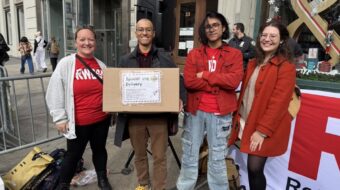
Earlier this month I marched for three days with Florida’s Immokalee farmworkers and their supporters. I was a “summer soldier” compared to the many marchers – young and old – who had joyfully trekked 200 miles during the two-week-long event.
The march began in Ft. Myers, Florida, and ended in Lakeland, the home office of Publix supermarkets. So far this corporate giant has refused to even sit down and talk with the Immokalee workers, let alone consider their main demand – a mere penny more per pound for the tomatoes they pick.
Even though I marched for only a few days, I left with many strong impressions and some conclusions.
First, I was impressed by the determination, spirit, and organization of these workers. For more than a decade they have been battling the powerful food industry. And yet they seem undeterred by the difficulty of their undertaking. Older as well as younger marchers had bounce in their step, exuded confidence in their cause, and displayed a remarkable and collective discipline.
I was also impressed by the broad alliance that has been built in support of the Immokalee workers. This didn’t happen spontaneously. Early on, these workers realized what more and more sections of the labor movement are concluding: Go-it-alone strategies don’t work in an economic and political environment dominated by mega-corporations. Only coalitions that reach outward as well as engage in militant actions, that activate the grassroots and that combine various forms of struggle have the capacity to stop and reverse the corporate counteroffensive.
This offensive, championed by the right and too little resisted by centrist and liberal forces, has been as much political and ideological as economic. It’s true that the economic terrain – offshoring, new technologies, the decline of old industries and the appearance of new ones, anemic recovery, etc. – shifted in ways that have been disadvantageous to the working class. But the main factor explaining the drop in living standards and erosion of rights of working people has been the one-sided intensification of the class struggle by the capitalist class starting nearly four decades ago.
Forty years later, this imbalance of power is being redressed as sections of labor like the Immokalee workers not only resist corporate power, but do it in new ways that accent the power of broad alliances and unity in action.
The presence of young activists in the march also made a big impression on me. Many were from college campuses; all were part of the sustainable food movement that has grown by leaps and bounds and links farm workers to activists in urban and campus settings. While a youth movement on the scale of the 1960s does not yet exist, growing youth activism around issues like this one bodes well for the future.
I was moved and even surprised by the support that the march received from Floridians driving by or watching from their homes or businesses. I have to admit that I’d expected some signs of hostility to the farm workers, most of whom are recent immigrants from Central America, but actually, I saw almost none of that. Instead, expressions of support were almost universal, and some were very enthusiastic. More than I appreciated, Florida appears to be changing under the impact of the economic crisis, shifting demographics, and declining support for right-wing politics.
Finally, the march reminded me once again that the barrier to economic justice is structured into the system of capitalism. Capitalists are greedy to be sure, but their greed is more than a misguided personal preoccupation. Their profit maximizing behavior springs from a system of social production whose inner logic requires of them the extraction of greater and greater profits from the labor of working people.
Some individual capitalists might even want to do the right thing. But the imperatives of intra-capitalist competition and capital accumulation compel them to constantly look for ways at the economic and political level to reduce the share of the product going to the worker, while maximizing the share going into their pockets for a fresh round of capital accumulation – not to mention their own luxury consumption.
This insight of Karl Marx and Frederick Engels led them to conclude that the mass struggles of working people and their allies to curb the excesses of capitalist society had to be coupled with battles to abolish the whole system of capitalist exploitation in favor of a just, democratic and free society – socialism.
The latter wasn’t on the agenda of the Immokalee workers this month, but in this era of deepening and generalized capitalist crisis it is not a stretch to think that growing sections of workers and their allies will consider more fundamental solutions to the seemingly intractable problems they encounter in their everyday lives.
Photo: Immokalee farm workers march for justice. Josh Leclair/PW







Comments